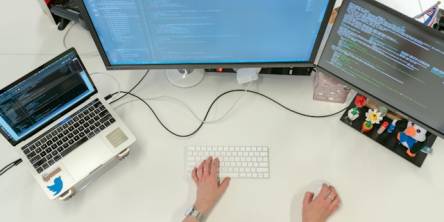Impact of IoT on Software Development Landscape

Our world is constantly changing, and that much has been for everyone to see. But what many people don't realize is that a lot of this change today is caused by the rapid advancement of technology. Also, do you know what has been among the most significant drivers of this change? The Internet of Things (IOT) is a network of interconnected physical gadgets, software, sensors, and more. empowers devices to connect and share information over the web. Such new-found levels of connectivity have permeated ordinary objects and appliances such as refrigerators, vehicles, thermostats, and even industrial equipment. Today, this equipment, empowered with intelligence, can gather, analyze, and transmit data without a fuss.
However, due to the exponential growth of connected devices, software development has also observed a profound shift. Developers are now faced with new challenges and possibilities as they build software for IoT interconnected devices. In this blog, I will walk you through the primary effects IoT has had on software development.
IoT and Software Development: A Quick Overview
The arrival of IoT brought in another layer to software development, requiring a comprehensive approach that envelops hardware interaction, data management, and powerful security. This shift involves a renewed focus on software development processes, with software being entrusted with overseeing device communication, sensor information processing, and consistent platform integration. Besides, there is also an increased focus on security, demanding careful measures to defend gadgets and the information they handle. As the range of abilities advances, programmers might wind up securing mastery in embedded systems, low-power development, and data analytics to satisfy the needs of this unique market.
How IoT Continues to Impact Software Development?
- Scaling to manage increased data volume: IoT brings with it a deluge of data sourced from numerous devices. This, in turn, drives the need for software that can efficiently manage large data streams. Hence, developers find themselves working on solutions that can handle this influx by using scalable databases, cloud technologies, etc. Other solutions that are conducive to scalability in this regard include optimized storage and processing mechanisms to prevent bottlenecks. This adaptation helps companies ensure smooth operation even as the volume of data continues to increase, aligning software development practices with the needs of the IoT landscape.
- Embracing real-time data processing: Real-time data processing is also integral to the inner workings of any IoT-based devices and solutions. As part of an IoT network, devices continually generate lots and lots of data, and the software must adeptly handle this influx. What I mean to say is that it should be able to process and analyze said data on the go to derive immediate insights as well as enable quick actions. For that, developers now employ technologies such as stream processing and real-time analytics.
- Decentralization: Decentralization is yet another one of the hallmarks of IoT systems, where devices are often distributed. To adapt to such an environment, software must be designed for decentralized processing. This is important for enabling data analysis at the device level. It is also crucial to establish secure communication channels between devices and central hubs, ensuring data integrity and privacy.
- Security enhancements: The expansive collection of interconnected devices in an IoT network increases the potential attack surface, thus demanding heightened security measures in software development. To prioritize robust security, developers must implement measures to protect devices and data from potential breaches. This translates into measures such as secure authentication and authorization protocols.
What are you waiting for then, folks? Go and start looking for a trusted and experienced enterprise application development services provider right away. Their expertise will go a long way towards ensuring your success.
Similar Articles
Compare hydraulic and traction residential elevators to find the best fit for your home. Learn how each system works, their pros and cons, space needs, energy use, and maintenance requirements.
Extend the lifespan of your commercial marina docks with proactive maintenance. Learn essential inspection routines, material-specific care, and safety tips to protect your investment and ensure long-term dock performance.
Learn the key factors in designing an engineered fall protection system. Discover how hierarchy of controls, task analysis, structural integrity, and fall clearance ensure safety and compliance.
Today, modern businesses face constant pressure to operate with maximum efficiency. This requires a technology infrastructure that is both agile and robust. However, the traditional model of on-premises data centers often has significant limitations. These legacy systems can drain valuable resources from teams.
When people are hungry, standing in line for a table feels tiring and unpleasant. In fact, research shows that most individuals will just walk away if they have to wait longer. They will go and find another place to eat.
In the early stages of designing new community centers, fire stations and administration buildings, city planners and architects are forced to make a crucial decision: What building material is best suited for providing the most value, safety and longevity to the public?
Amazon Simple Queue Service (SQS), Simple Notification Service (SNS), and EventBridge are just a few of the messaging services that AWS provides to meet various demands when it comes to creating scalable and effective cloud systems.
Wearable technology, embracing devices small enough to be worn unobtrusively, constitutes a market that keeps expanding, and the momentum shows little sign of slowing
For job seekers, grasping the basic functions of Applicant Tracking Systems (ATS) is the first step in overcoming common job search barriers.









